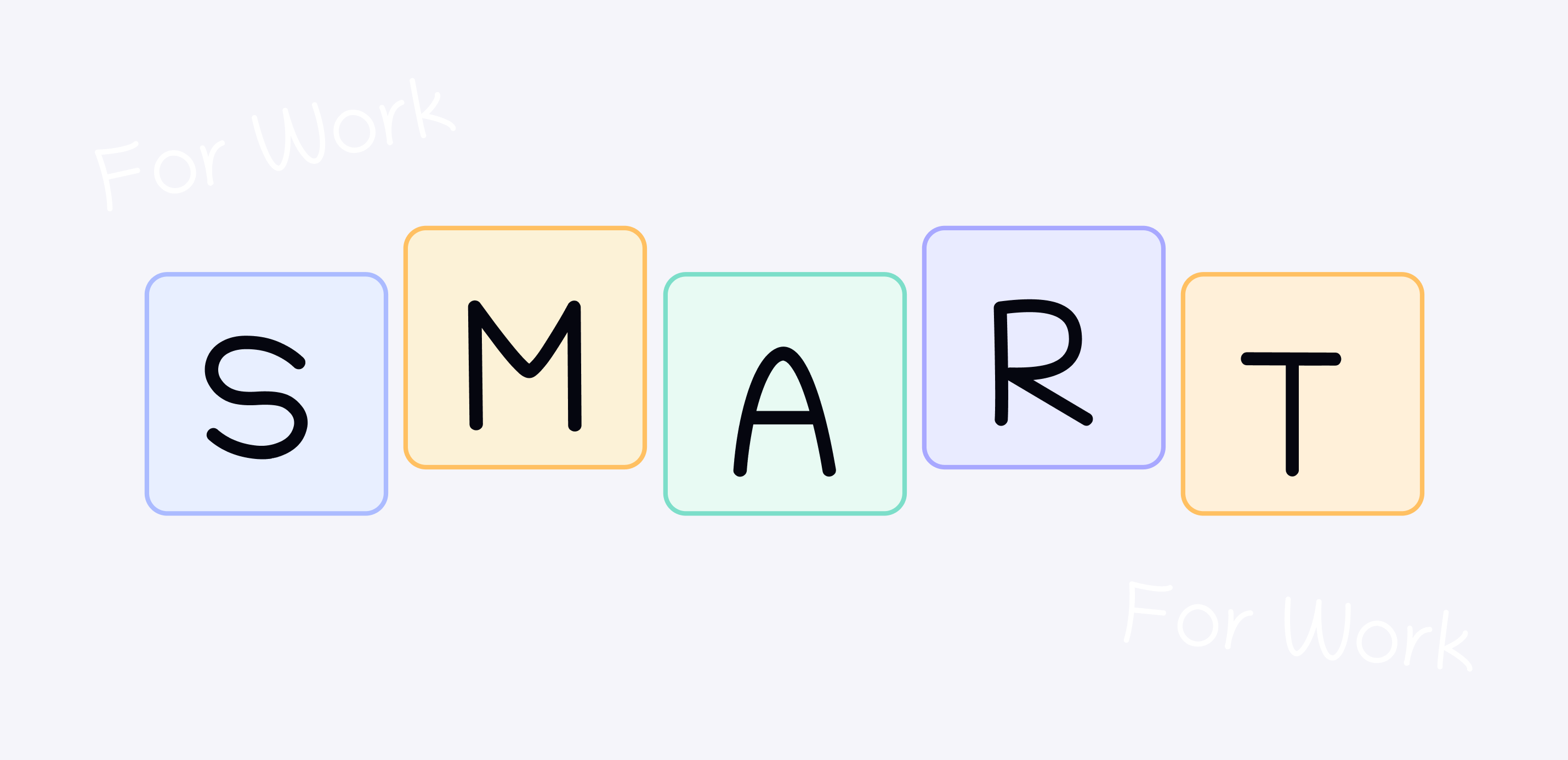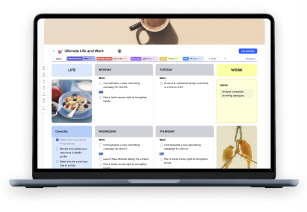Writing your goals down, whether digitally or on paper, creates a contract with yourself, a tangible connection between your dreams and aspirations and your reality and future. Goals that stay in mind tend to remain there even if you have multiple opportunities to make them come true.
The SMART Goals methodology is what can help you turn your aspirations into something that can work and bring benefits. It can become especially useful for your professional development and career success.
“If you have built castles in the air, your work need not be lost; that is where they should be. Now put the foundations under them.” ― Henry David Thoreau
Let’s learn what SMART work goals are and what they can be to put the foundation under your work goals.
What is a SMART goal?
.webp)
SMART goals are a framework for professional development and success. It allows one to set and achieve goals in both personal and professional life.
By using the SMART framework, team members and leaders can set clear goals that align with the bigger organizational goals. This alignment means individual efforts contribute directly to team productivity and overall company success.
SMART goals are especially great for:
- When you want to learn a new skill
- For leadership development/employee development
- For personal development
- When you want to improve your time management skills
- For boosting customer satisfaction
- When you want to establish a healthy work-life balance
Setting and implementing SMART goals allows you to track progress, measure success, and adjust as needed. This framework also creates a positive work culture by giving clear direction and employee engagement. Companies that use the methodology have more chances to make new hires interested by providing them with a clear understanding of what they need to do, how they need to do it, and within what timeframe it has to be done.
The technique can be applied on paper with a pencil. However, to use SMART goals effectively, consider using project management tools, regular check-ins, and measurable outcomes. This will help your personal and professional growth, team cohesion, and organizational success.
SMART goal framework was originally created for working purposes to help people with career progression and leadership development. However, it proved to be so effective in the corporate sphere that many people have started to implement it for their other tasks. For example, more and more students use the SMART goals methodology for academic success.
In summary, SMART goals give you a structured way to achieve short-term and long-term career goals. You can develop your skills, contribute more to your team, and drive your career forward in line with the broader organizational objectives.
How does the SMART goals framework work?
The SMART framework is easy to use. All you need is to know what the acronym stands for.
Here is how it works:
- S – Specific
Goals should be specific. Instead of a vague goal like “increase sales,” a specific goal would be “increase product X sales by 20% in X area.”
- M – Measurable
Establish concrete criteria for measuring progress. This could involve using success metrics or key performance indicators (KPIs) to track advancement towards the goal.
- A – Achievable
Goals should be ambitious but realistic, given the resources and constraints. This balance challenges the individual or team without being demotivating.
- R – Relevant
Goals should align with bigger objectives, personal or organizational. This relevance means achieving the goal contributes to overall success and career development.
- T – Time-bound
Set a deadline for the goal. This creates a sense of urgency and helps prioritize.
Setting SMART goals involves a goal-setting process:
- Define the outcome
- Apply the SMART criteria to the goal
- Write it down and share with relevant people
- Create an action plan with milestones
- Review and adjust regularly
The framework is very flexible. It can be used for personal development and strategic planning. It’s especially useful for cross-functional projects where clear communication of objectives is key.
10 Examples of SMART goals for work
We will go through specific examples of SMART goals from different spheres of work life and routine to get a deeper understanding of how the SMART goals work. You can use these goals in your practice; however, remember that details such as timeframes and growth percentages can vary depending on your current data and capacity.
1. Project Management SMART Goal Example
.webp)
The goal without the SMART methodology: Finish the project X faster.
SMART goal: Finish the project X in 5 months instead of 6 months, preserving the same quality and budget.
Specific: This goal means finishing Project X faster and more precisely. It focuses on a specific cross-functional project and cuts costs without sacrificing quality.
Measurable: Reducing the project timeline from 6 to 5 months is a concrete metric. This one-month drop offers a clear benchmark for success. Budget constraints and upholding quality standards can provide more measurable targets.
Achievable: Reducing the schedule to 5 months from 6 months is an ambitious but achievable goal. This goal is based on the team’s ability to achieve this efficiency improvement through better project management practices, more teamwork, and project management tools like xTiles.
Relevant: Improving the speed of cross-functional projects benefits the organization. It shows improved project management skills, fosters departmental collaboration, and may result in lower cost and faster time-to-market for the company’s initiatives.
Time-bound: By saying the goal will be done in 5 months instead of 6 months, there’s a time constraint. Throughout the project lifecycle, this specific deadline creates urgency and helps in prioritizing resourcers.
2. Leadership Development SMART Goal Example

The goal without the SMART methodology: Become a better team leader.
SMART goal: Enhance leadership skills by completing an 8-week leadership training program and successfully leading two team-building activities in the next quarter.
Specific: This goal provides a clear path for professional development by outlining two very concrete actions to polish leadership capabilities: complete a program and organize and lead team activities.
Measurable: The goal includes quantifiable elements – an 8-week program and two activities, allowing the team member assigned with the task to build the schedule accordingly and track progress.
Achievable: A quarter is enough time to complete an 8-week program and organize two team-building events for most professionals.
Relevant: Enhancing leadership skills is crucial for a team leader’s growth and might positively impact team morale and overall productivity after the quarter dedicated to the execution or even starting during this period. Additionally, this goal aligns with broader career advancement objectives and organizational needs.
Time-bound: The goal specifies a clear timeframe – the next quarter – creating urgency (but not the urgency that will create immense pressure on the person responsible, making them feel overwhelmed and anxious) and helping to prioritize this development alongside other responsibilities.
3. Time Management SMART Goal Example
.webp)
The goal without the SMART methodology: Improve time management skills within the team.
SMART Goal: Improve team time management skills by implementing a new project management software and reducing weekly overtime hours by 25% within 3 months.
Specific: This goal defines two clear actions: get new project management software and reduce overtime. It provides a strategy for better time management for the team leader and the entire team.
Measurable: The goal has a quantifiable target to reduce overtime by 25%. The team leader can measure progress over 3 months. The successful software implementation is another milestone that can be measured.
Achievable: A 25% reduction in overtime might seem ambitious (especially if the team is in the middle of something highly important or they are short-stuffed). Yet, it is still realistic with wise project management that takes care of their employee’s job satisfaction and the aid of new software to streamline processes. This target strikes a balance between challenge and attainability.
Relevant: Improved time management within a team directly contributes to increased productivity, better work-life balance, organizational success, and higher employee satisfaction. These outcomes are crucial for individual performance and team morale.
Time-bound: The goal sets a clear three-month timeframe, creating urgency, which will motivate the team leaders to work consistently on this goal while still offering enough time for a comfortable pace implementation of new software.
4. Customer Satisfaction SMART Goal Example

The goal without the SMART methodology: Improve customer satisfaction.
SMART Goal: Increase customer satisfaction ratings from 85% to 90% by the end of the fiscal year through improved response times and personalized follow-ups.
Specific: This goal is very clear – to increase customer satisfaction ratings by 5%. It outlines two specific actions: quicker response times and personalized follow-ups. Everyone from the project manager to the customer service team is on the same page and knows what to focus on.
Measurable: We have a number to move from 85% to 92% satisfaction. A number we can track and measure the project’s success.
Achievable: A 5% increase over a fiscal year is an ambitious, yet attainable goal. It challenges the team without setting an unrealistic target that might demoralize the staff.
Relevant: Improving the customer satisfaction is crucial for any business prosperity and improvement. It potentially leads to a strong professional network of happy clients and impacts customer retention and word-of-mouth referrals.
Time-bound: The goal specifies completion by the end of the fiscal year, providing a clear deadline for achieving the target.
5. Employee Engagement SMART Goal Example

The goal without the SMART methodology: Improve employee engagement.
SMART Goal: Boost employee engagement scores from 70% to 80% within 6 months by implementing bi-weekly team meetings and a structured feedback system.
Specific: This goal has two key actions to increase employee engagement: bi-weekly team meetings and a feedback system. These will improve communication skills and support employee development.
Measurable: The goal has a measurable target to increase engagement scores from 70% to 80%. 10% is a clear benchmark to measure progress and success.
Achievable: 10% in 6 months is challenging but doable. It will enhance their management skills and set a target that motivates rather than overwhelms the team.
Relevant: Employee engagement directly contributes to business success by having a more committed and productive workforce. This goal fits with the professional smart goals of having a positive work environment and retaining top talent.
Time-bound: The six-month timeframe provides a clear deadline, creating a sense of urgency and allowing for regular progress checks and strategy improvements if needed.
6. Professional Networking SMART Goal Example
.webp)
The goal without the SMART methodology: Network more and meet new people in the industry.
SMART Goal: Expand professional network by attending 3 industry conferences and connecting with 20 new contacts in the field over the next year.
Specific: This goal has two clear actions to grow your professional network: attend industry conferences and make new connections. These are key for career development and industry knowledge goals.
Measurable: The goal has numbers – 3 conferences and 20 new connections. These are concrete metrics to measure progress and success.
Achievable: 3 conferences and 20 new connections in a year is more than possible for most people. It will challenge you enough to get you out of your comfort zone but it won’t be so hard that it becomes discouraging.
Relevant: Growing your professional network is important for career growth and learning about industry trends. It ties in with broader career goals and can lead to collaborations.
Time-bound: The goal has a specific timeframe of one year, so you have a sense of deadline and can schedule networking activities alongside other professional responsibilities.
7. Communication Skills SMART Goal Example

The goal without the SMART methodology: Get better at communicating with the team.
SMART Goal: Enhance communication skills by delivering 5 presentations to the broader team and reducing email response time to within 24 hours over the next quarter.
Specific: This goal defies two specific actions to improve communication: deliver presentations and reduce email response time. Both verbal and written communication skills are covered.
Measurable: There are strict numbers – 5 presentations and 24 hours. They are easy to track and clear enough to monitor your progress.
Achievable: Delivering 5 presentations in a quarter (about 1 every 2-3 weeks) and 24-hour email response time is a challenging but realistic target for most people. This objective can push for improvement without causing stress.
Relevant: Communication skills are key to professional development no matter what position you occupy and can boost both personal and team productivity. Better communication always means clearer expectations, fewer misunderstandings, and more efficient collaboration, which equals team and organizational success.
Time-bound: The goal is for one quarter, so there is a deadline and regular check-ins. This time constraint helps prioritize these communication improvement efforts alongside other responsibilities.
8. Career Advancement SMART Goal Example

The goal without the SMART methodology: Get promoted to a higher position in the company.
SMART Goal: Secure a promotion to senior manager within 18 months by exceeding quarterly targets by 10% and completing an advanced certification in the field.
Specific: The goal defines two clear actions for career advancement: exceed performance targets and get certified. Both of them are enough to achieve success, yet they won’t lead a person to burnout. They are balanced to preserve enough time for personal life.
Measurable: The goal has quantifiable targets – exceed quarterly targets by 10% and get certified. These are measurable ways to track progress and show you’re ready for the promotion.
Achievable: The goal is ambitious but doable for a high performer. Exceeding targets by 10% is tough but possible with focus. Getting certified in 18 months is also possible with time management skills.
Relevant: This goal is aligned with the individual’s career goals and the company’s needs. Making sure these two meet, guarantees promotion.
Time-bound: 18 months gives a deadline, creates urgency, and helps to focus on actions. It gives enough time to consistently perform high and get certified while still maintaining a sense of momentum. However, since it’s only an example, the time frame can be 24, 30, or even more months depending on the current position, skills, etc.
9. Work-Life Balance SMART Goal Example

The goal without the SMART methodology: Improve my work-life balance.
SMART Goal: Achieve a healthier work-life balance by reducing after-hours work emails by 50% and using all allocated vacation days within the next 6 months.
Specific: Two concrete actions to improve work-life balance: reduce after-hours emails and use allocated vacation days. These are clear steps to get a better balance between work and life.
Measurable: The goal has metrics – a 50% reduction in after-hours emails and the use of all vacation days. These are measurable ways to track progress and measure work-life balance.
Achievable: The task might seem super hard for workaholics or people who devote all of their time to work. That’s why this task might require some additional activities, like getting a hobby that will “steal” a bit of your time.
Relevant: This goal hits the work-life balance nail on the head, which is key to long-term job satisfaction, mental health, and overall happiness. Even though it might seem that such a goal prevents you from getting a promotion or recognition at work, when planned and executed wisely, the fact that you spend less time on work won’t slow your professional development.
Time-bound: The 6-month timeframe gives a deadline, creates urgency, and helps to prioritize. It’s enough time to change habits and plan for vacation use.
10. Strategic Planning SMART Goal Example

The goal without the SMART methodology: Come up with a plan for the department’s future.
SMART Goal: Develop and present a comprehensive 5-year strategic plan for the department, aligning with broader organizational objectives, by the end of the next quarter.
Specific: This goal is clear – a 5-year plan for the department. It also specifies that the plan has to be presented to the company’s executives.
Measurable: There are quantifiable details of the plan – a 5-year plan by the end of the next quarter. We can track progress and have a clear end point for the project.
Achievable: A 5-year plan in a quarter is tough but possible for most professionals with planning experience and a deep understanding of their department’s contribution to the company’s success. The timeframe allows for research, team collaboration, and refinement.
Relevant: This goal is directly connected to the department’s future and its place in the organization.
Time-bound: It has a clear deadline – the end of the next quarter. It creates a sense of pressure and helps to prioritize the planning alongside other department responsibilities.
xTiles Smart Goals Template

Setting SMART goals can be easy, even if it is your first time. The xTiles SMART Goals Template belongs to a group of productivity templates and provides a structured approach to goal setting, and includes all the key elements of the SMART methodology.
To use this template effectively, work through each of the SMART elements, making sure your goal is Specific, Measurable, Achievable, Relevant, and Time-bound. The template will guide you through this process and prompt you to think and articulate each part of your goal.
A unique feature of the xTiles template is the notes section. Use this space to jot down ideas, potential obstacles, resources needed, or any other thoughts that come to mind during the planning process. This section helps with full planning and captures valuable insights that might come to your mind while working on all elements of your SMART goal.
You can add new pages or groups of pages to the template so you can manage multiple goals from a unified place. This is great for managing different areas of your life or work. For example, you can have separate page groups for personal goals, professional goals, or team goals.
How to track the progress of your SMART goals?
You need to monitor your SMART Goals to make sure you’re on track. These consistent checks mean that sometimes you need much more than take a look.
Start by breaking down your goal into smaller milestones or tasks with deadlines. A detailed strategy will allow you to track progress and adjust as needed easily if you need to adjust some bigger tasks.
Use metrics and KPIs to measure success. Establish these metrics according to your task. Review your data regularly to see trends or roadblocks that might affect your progress.
Finally, get feedback. For goals related to team performance or customer satisfaction, surveys or feedback forms can give you insight into if you’re heading in the right direction.
Lastly, schedule regular check-ins to review progress. This could be weekly, monthly, or quarterly, depending on the goal timeframe. These check-ins will allow you to adjust your approach, allocate resources, or set new milestones.
Conclusion
The SMART goals framework is a great way to set and achieve goals in both personal and professional life. By makingyour goals Specific, Measurable, Achievable, Relevant, and Time-bound you create a clear path to success. This turns vague wishes into concrete plans and increases your chances of achieving your dreams.
Whether you want to advance your career, improve team performance, improve personal skills, or achieve a better work-life balance, SMART goals give you the structure and clarity to make progress. Remember, the key is not just to set these goals but to review and adjust them as circumstances change.
To simplify your goal setting and increase your chances of success, use the xTiles SMART Goals Template. This easy-to-use tool walks you through each step of the SMART framework and helps you create clear goals in minutes. With its simple interface and customizable features, the xTiles template does much of the goal-setting for you and ensures you don’t miss anything. Additionally, it offers the flexibility needed for adjustment to ensure your goals are up to date.
.webp)
FAQ
What does the SMART acronym stand for?
SMART stands for Specific, Measurable, Achievable, Relevant and Time-bound. These criteria help turn vague wishes into clear goals.
How to set a SMART goal?
To set a SMART goal, define the outcome you want and apply the SMART criteria to it. Write it down, share it with others, create a plan with milestones, and review and adjust regularly.
What are some SMART goals examples?
Examples include improving customer satisfaction ratings, leadership skills through training, streamlining project timelines, expanding professional networks, and work-life balance. Each example in the article demonstrates how to apply the SMART criteria to various professional objectives.
Can I use the SMART goals framework in my everyday life, or is it suitable only for work goal setting?
While created for work, the SMART goals framework has been used in many areas of life. It can be applied to personal development, academic success, and other areas beyond your workplace.
How will the xTiles SMART Goals Template help me with setting smart goals?
The xTiles SMART Goals Template is a structured goal-setting tool that will guide you through each SMART element. It has a notes section to capture ideas, and you can add multiple pages or groups to manage multiple goals from one place.









